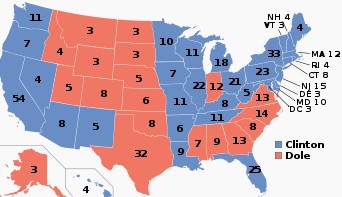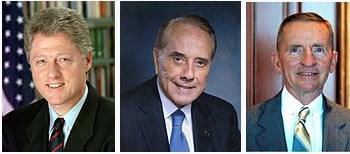
United States presidential election of 1996
Wikipedia | 2013-01-10 11:20
| United States presidential election, 1996 | ||||||||||||||||||||||||||||||||||||||||||||||||
|
||||||||||||||||||||||||||||||||||||||||||||||||
|
||||||||||||||||||||||||||||||||||||||||||||||||

|
||||||||||||||||||||||||||||||||||||||||||||||||
| Presidential election results map. Red denotes states won by Dole/Kemp, Blue denotes those won by Clinton/Gore. | ||||||||||||||||||||||||||||||||||||||||||||||||
|
||||||||||||||||||||||||||||||||||||||||||||||||
The United States presidential election of 1996 was a contest between the Democratic national ticket of President Bill Clinton from Arkansas and Vice President Al Gore from Tennessee and the Republican national ticket of former Senator Bob Dole of Kansas for President and former Housing Secretary Jack Kemp from New York for Vice President. Businessman Ross Perot ran as candidate for the Reform Party with economist Pat Choate as his running mate; he received less media attention and was excluded from the presidential debates and, while still obtaining substantial results for a third-party candidate, by U.S. standards, did not renew his success of the 1992 election. Clinton benefited from an economy which recovered from the early 1990s recession and a relatively stable world stage. On November 5, 1996,[2] President Clinton went on to win re-election with a substantial margin in the popular vote and electoral college.
General election
Campaign
Without meaningful primary opposition, Clinton was able to focus on the general election early, while Dole was forced to move to the right and spend his campaign reserves fighting off challengers. Political adviser Dick Morris urged Clinton to raise huge sums of campaign funds via soft money for an unprecedented early TV blitz of swing states promoting Clinton's agenda and record. As a result, Clinton could run a campaign through the summer defining his opponent as an aged conservative far from the mainstream before Dole was in a position to respond. Compared to the 50-year-old Clinton, then 73-year-old Dole appeared especially old and frail, as illustrated by an embarrassing fall off a stage during a campaign event. Dole further enhanced this contrast on September 18 when he made a reference to a no-hitter thrown the day before by Hideo Nomo of the “Brooklyn Dodgers”, a team that had left Brooklyn for Los Angeles four decades earlier. A few days later Dole would make a joke about the remark saying "And I'd like to congratulate the St. Louis Cardinals on winning the N.L. Central. Notice I said the St. Louis Cardinals not the St. Louis Browns." (The Browns had left St. Louis after the 1954 season to become the Baltimore Orioles.)
With respect to the issues, Dole promised a 15% across-the-board reduction in income tax rates and made former Congressman and supply side advocate Jack Kemp his running mate. Bill Clinton framed the narrative against Dole early, painting him as a mere clone of unpopular House Speaker Newt Gingrich, warning America that Bob Dole would work in concert with the Republican Congress to slash popular social programs, like Medicare and Social Security, dubbed by Clinton as "Dole-Gingrich".Bob Dole's tax-cut plan found itself under attack from the White House, who said it would "blow a hole in the deficit" which had been cut nearly in half during his opponent's term.
Throughout the run-up to the general election, Clinton maintained comfortable leads in the polls over Dole and Perot. The televised debates featured only Dole and Clinton, locking out Perot and the other minor candidates from the discussion. Perot, who had been allowed to participate in the 1992 debates, would eventually take his case to court, seeking damages from not being in the debate, as well as citing unfair coverage from the major media outlets.
Throughout this campaign, Clinton was always leading in the polls, generally by large margins.
Campaign donations controversy
In late September 1995, questions arose regarding the Democratic National Committee's fund-raising practices. In February the following year, China's alleged role in the campaign finance controversy first gained public attention after the Washington Post published a story stating that a U.S. Department of Justice investigation had discovered evidence that agents of China sought to direct contributions from foreign sources to the DNC before the 1996 presidential campaign. The paper wrote that intelligence information had showed the Chinese Embassy in Washington, D.C. was used for coordinating contributions to the DNC in violation of U.S. law forbidding non-American citizens from giving monetary donations to U.S. politicians and political parties. Seventeen people were eventually convicted for fraud or for funneling Asian funds into the U.S. elections.
One of the more notable events learned involved Vice President Al Gore and a fund-raising event held at Hsi Lai Temple in Hacienda Heights, California. The Temple event was organized by DNC fund-raisers John Huang and Maria Hsia. It is illegal under U.S. law for religious organizations to donate money to politicians or political groups due to their tax-exempt status. The U.S. Justice Department alleged Hsia facilitated $100,000 in illegal contributions to the 1996 Clinton-Gore re-election campaign through her efforts at the Temple. Hsia was eventually convicted by a jury in March 2000.The DNC eventually returned the money donated by the Temple's monks and nuns. Twelve nuns and employees of the Temple refused to answer questions by pleading the Fifth Amendment when they were subpoenaed to testify before Congress in 1997.
Results
On election day, President Clinton won a decisive victory over Dole, becoming the first Democrat to win presidential reelection since Franklin Roosevelt. In the popular vote, he outpolled Dole by over 8.2 million votes. The Electoral College map did not change much from the previous election, with the Democratic incumbent winning 379 votes to the Republican ticket's 159. In the West, Dole managed to narrowly win Colorado and Montana (both had voted for Clinton in 1992), while Clinton became the first Democrat to win the state of Arizona since Harry Truman in 1948. In the South, Clinton took Florida-a state which he failed to win in 1992- from the Republicans in exchange for the less electoral-vote-rich Georgia. The election helped to cement Democratic Presidential prospects in states including California, Vermont, Maine, Illinois, New Jersey, Pennsylvania, Michigan, Delaware, and Connecticut; all went on to vote Democratic in subsequent Presidential elections, having voted Republican in the three prior to 1992. Those states also voted for Richard Nixon in the 1972 landslide. 1996 marked the first time that Vermont voted for a Democrat in two successive elections.
Reform Party nominee Ross Perot won approximately 8% of the popular vote. His vote total was less than half of his performance in 1992. The 1996 national exit poll showed that just as in 1992, Reform Party nominee Ross Perot's supporters drew from Clinton and Dole equally.[19] In polls directed at Perot voters as to who would be a second choice, Clinton consistently held substantial leads.
Although he hailed from Arkansas, Clinton carried just four of the eleven states of the American South, tying his 1992 run for the weakest performance by a winning Democratic presidential candidate in the region before 2000 (in terms of states won). Clinton's performance seems to have been part of a broader decline in support for the Democratic Party in the South. In the 2000 and 2004 elections, the Democrats would fail to carry even one of the Southern states, contributing to their defeat both times. This completed the Republican takeover of the American South, a region in which Democrats had held a near monopoly from 1880 to 1960. However, in 2008, the Democrats were able to win three Southern States, but that was still worse than Clinton's performances in both 1992 and 1996. This was the last election in which a third-party candidate carried over 3% of the national popular vote. Since 1984, no winning Presidential candidate has surpassed Bill Clinton's 8.5 percentage popular vote margin, or his 220 electoral vote margin since 1988. Also note that no Democratic Presidential candidate has surpassed Clinton's 8.5 percentage popular vote margin since 1940 (except 1964), and no Democratic Presidential candidate has surpassed his electoral vote margin since 1964. The election was also notable for the fact that for the first time in U.S. history the winner was elected without winning the male vote and the third time in U.S. history that a candidate was elected President twice without receiving an absolute majority of the popular vote in either election (Grover Cleveland and Woodrow Wilson are the others, although all three won pluralities [i.e. the most votes]).
Share this page




















